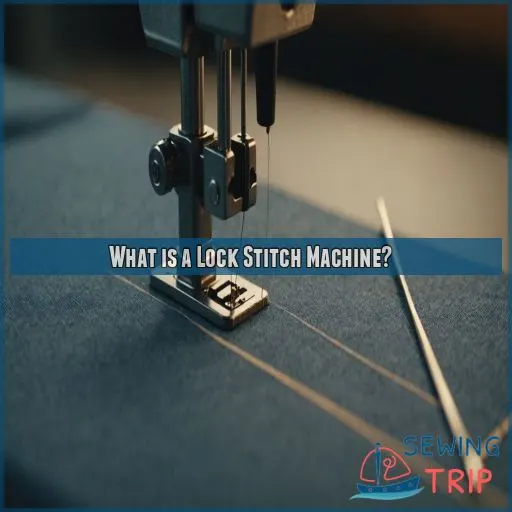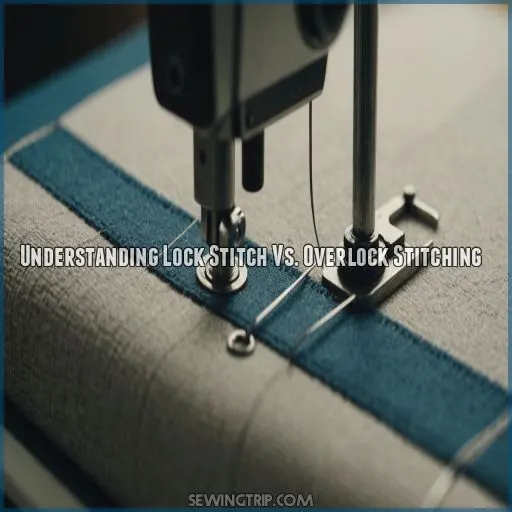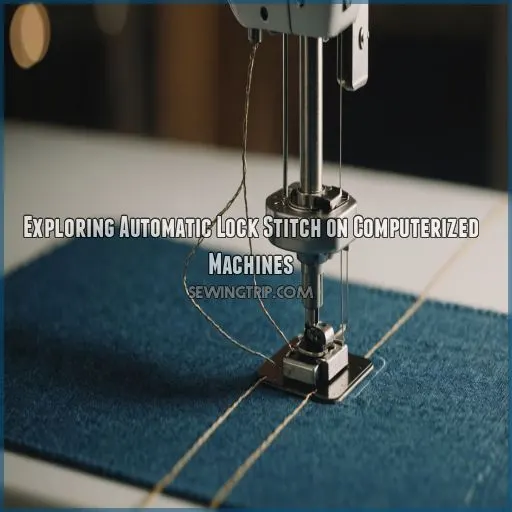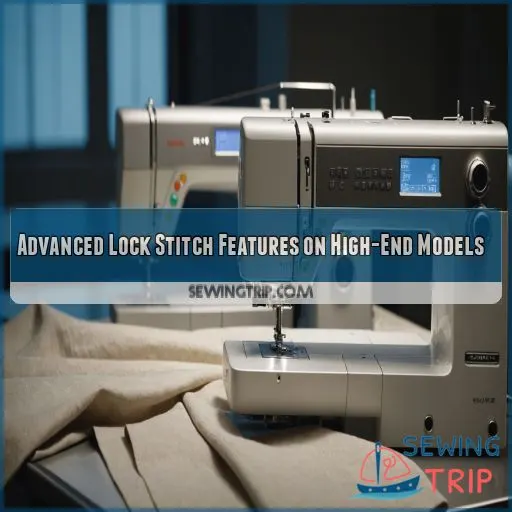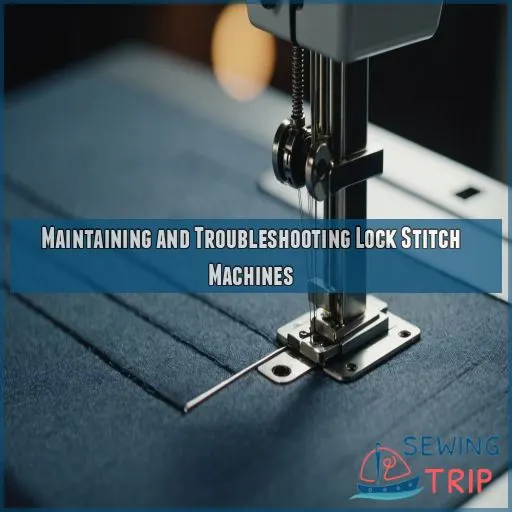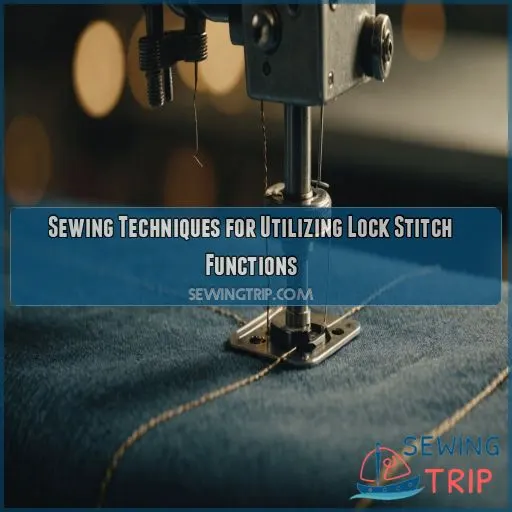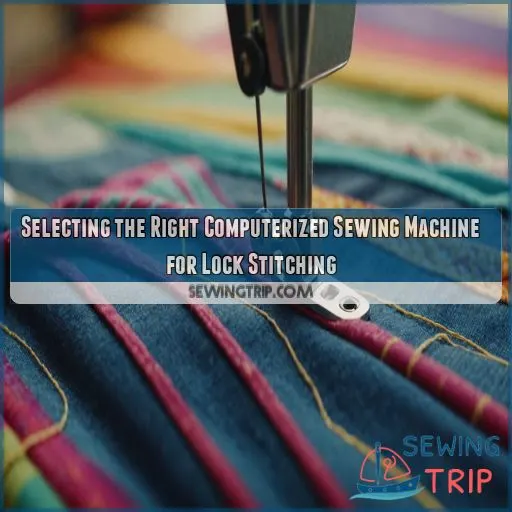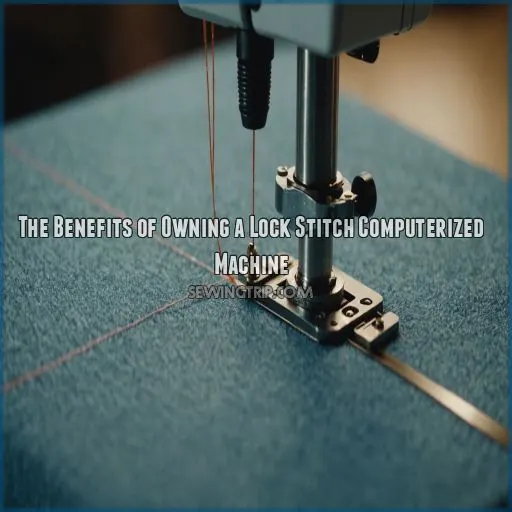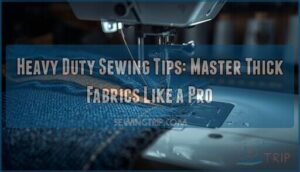This site is supported by our readers. We may earn a commission, at no cost to you, if you purchase through links.
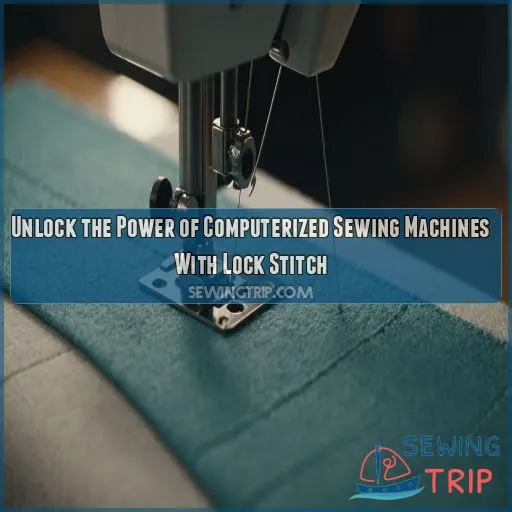
You’ll enjoy enhanced stitch quality, faster sewing, and reduced puckering across a wide range of fabrics – from delicate silks to heavy-duty upholstery.
Customizable settings let you fine-tune the look, while automated functions like quick-set bobbins and thread trimmers save you time.
Whether you’re a seasoned sewer or just starting out, a computerized lock stitch machine can take your projects to the next level of precision and polish.
Table Of Contents
- Key Takeaways
- What is a Lock Stitch Machine?
- Understanding Lock Stitch Vs. Overlock Stitching
- Exploring Automatic Lock Stitch on Computerized Machines
- Top 5 Computerized Sewing Machines With Lock Stitch Feature
- Advanced Lock Stitch Features on High-End Models
- Maintaining and Troubleshooting Lock Stitch Machines
- Sewing Techniques for Utilizing Lock Stitch Functions
- Selecting the Right Computerized Sewing Machine for Lock Stitching
- The Benefits of Owning a Lock Stitch Computerized Machine
- Frequently Asked Questions (FAQs)
- Conclusion
Key Takeaways
- Embrace the power of professional-grade stitches with lock stitch computerized machines – you’ll enjoy enhanced stitch quality, faster sewing, and reduced puckering across a wide range of fabrics. Dial in the perfect look with customizable settings and automated functions like quick-set bobbins and thread trimmers.
- Discover the magic of lock stitches – these durable, symmetrical seams interlock needle and bobbin threads to create secure, unraveling-resistant stitches. Leverage this versatile feature to tackle everything from quilting and garment construction to home decor and crafts.
- Unleash the full potential of your computerized machine’s automatic lock stitch function – just press a button, and the machine’s precise needle timing, balanced tension, and smooth stitch formation will do the rest, delivering professional results with effortless ease. Check out this guide if you’re having trouble with your machine’s timing.
- Take your lock stitching to the next level with advanced features like programmable functions, adjustable stitch length and width, and integrated needle positioning. Elevate your creativity and maintain your machine with expert tips on needle and thread selection, tension adjustments, and cleaning and oiling.
What is a Lock Stitch Machine?
Are you tired of ripped seams and unraveling threads?
Lock stitch machines are here to save the day. These powerhouses of precision sewing combine cutting-edge technology with industrial-strength performance, allowing you to tackle even the most demanding projects with ease.
Definition and Mechanics of a Lock Stitch
A lock stitch is the foundation of sewing machine stitches.
The lock stitch is created when the needle thread intertwines with the bobbin thread to form a strong, durable seam.
This two-thread mechanism makes sure your projects hold together securely.
Whether you’re sewing clothing, crafting quilts, or upholstering furniture, mastering the lock stitch opens up a world of sewing possibilities.
Key Features and Benefits of Lock Stitch Machines
For computerized sewing machines, the lock stitch feature is a game-changer.
These machines use an industrial-grade mechanism to create secure, durable stitches that won’t unravel, even on thick fabrics or through heavy use.
Plus, with customizable stitch length and width, you can dial in the perfect look for any project.
Applications and Suitability for Different Projects
From quilting intricate patterns to applying sturdy zipper seams, your lock stitch computerized sewing machine is a versatile companion that can handle a wide range of sewing projects with ease.
Whether you’re crafting home decor, garments, or even upholstery, this machine’s locking stitch capabilities open up a world of creative possibilities.
- Quilting and Patchwork: Achieve precisely locked stitches for durable seams on quilt sandwiches.
- Garment Construction: Secure hems, seams, and buttonholes with the reliable lock stitch function.
- Home Decor and Upholstery: Stitch sturdy, long-lasting seams on fabrics like curtains, pillows, and furniture.
- Craft Projects: Explore combined utility and decorative stitches for unique embellishments and custom touches.
Understanding Lock Stitch Vs. Overlock Stitching
When you’re sewing, understanding the differences between lock stitch and overlock stitching is really important.
Lock stitch and overlock stitching each have their own unique advantages.
Knowing when to use them can make all the difference in the quality and durability of your sewing projects.
Differences in Stitch Formation
Two common stitch types, the lock stitch and the overlock stitch, differ in their formation.
The lock stitch interlocks threads above and below the fabric, creating a secure seam.
In contrast, the overlock stitch wraps threads around the fabric edge, providing a finished, reinforced look.
Understanding these distinctions can help you choose the right stitch for your sewing projects.
| Feature | Lock Stitch | Overlock Stitch |
|---|---|---|
| Thread Interlocking | Above and below fabric | Around fabric edge |
| Seam Strength | Strong, durable | Reinforced, but not as strong |
| Fabric Tension | Minimal tension required | Higher tension needed |
Advantages and Disadvantages of Each Stitch Type
The choice between lock stitch and overlock stitching is a big decision that can make or break your sewing projects. Your project needs and personal preferences will guide you to the best stitch choice.
The advantages of lock stitch include superior stitch quality, enhanced durability, and versatility for various fabric types.
Here are some key differences between lock stitch and overlock stitching:
- Stitch Quality: Lock stitches provide a clean, uniform appearance.
- Stitch Durability: Lock stitches are less prone to unraveling.
- Fabric Compatibility: Lock stitches handle a wider range of fabrics.
- Project Suitability: Overlock stitches excel for finishing seams on stretchy materials.
- Time Efficiency: Overlock stitching can be faster for certain applications.
Choosing the Right Stitch for Your Sewing Needs
Choosing the right stitch for your sewing needs can be tricky. You’ll want to weigh the pros and cons of lock stitch versus overlock stitching.
Lock stitches are renowned for their strength and durability, making them ideal for heavy fabrics and garment construction.
Overlock stitches, on the other hand, offer a more decorative finish and can handle stretchy materials with ease.
Consider your project requirements, fabric type, and desired aesthetic to pick the perfect stitch:
| Stitch Type | Advantages | Disadvantages |
|---|---|---|
| Lock Stitch | Durable, Strong, Ideal for Heavy Fabrics | Limited Stretch, Less Decorative |
| Overlock Stitch | Decorative, Accommodates Stretch | Less Durable, Not Suitable for Heavy Fabrics |
Exploring Automatic Lock Stitch on Computerized Machines
You’ll be thrilled to discover how computerized sewing machines elevate your sewing game.
Automatic lock stitch is a nifty feature that seamlessly secures your stitches.
This feature saves you time and ensures professional results – all at the press of a button.
How Automatic Lock Stitch Works
Computerized sewing machines take the guesswork out of this intricate stitch, especially when looking for features like automatic needle up/down. The machine precisely coordinates the needle, bobbin, and thread tension to create those secure, symmetrical stitches you crave.
How It Works
With the push of a button, you can bid farewell to messy, unraveling seams and embrace the power of reliable, professional-grade locking stitches.
Key Features of Automatic Lock Stitch
- Precise Needle Timing: The machine precisely coordinates the needle’s up-and-down motion with the bobbin thread’s loop formation.
- Balanced Tension: Automatic tension adjustments make sure the top and bottom threads interlock for a strong, uniform stitch.
- Smooth Stitch Formation: The machine’s internal mechanisms seamlessly guide the thread through the fabric for a polished, consistent look.
- Effortless Operation: Simply select your stitch and the machine handles the rest, letting you sew with confidence and ease.
Benefits of Automatic Lock Stitch Function
Let’s unpack the perks of automatic lock stitch – you’ll enjoy seamless finishes, faster sewing, and reduced puckering.
Plus, your creations will have enhanced durability and way less thread waste.
Computerized machines with built-in locking stitches, cross stitches, and satin stitches make precision sewing a breeze with adjustable foot pressure.
Customizing Automatic Lock Stitch Settings
You’ve mastered the automatic lock stitch – now it’s time to get the most out of it.
Tweak the stitch length and tension to suit your fabric.
Fine-tune the density for a professional finish.
Don’t be afraid to experiment – your machine’s customizable settings are the key to maximizing your creative sewing possibilities.
Top 5 Computerized Sewing Machines With Lock Stitch Feature
You’ve got the basics of lock stitch down.
It’s time to explore the top computerized sewing machines that offer this powerful feature.
From advanced quilting machines to versatile embroidery models, we’ve got the top 5 picks to help you take your sewing to the next level.
1. Janome Quilting Sewing Machine with Kit
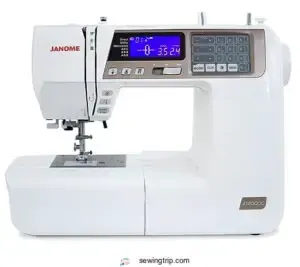
If you’re a quilting enthusiast, the Janome Quilting Sewing Machine with Kit is a real gem. This machine boasts an impressive 120 built-in stitches, including a range of quilting-friendly options. The easy-to-use control panel and LCD screen make stitch selection a breeze, while the automatic needle threader and top-loading bobbin system simplify setup. With its sturdy aluminum frame and handy function buttons, this Janome model is built to handle even the most intricate quilting projects. And the included extension table provides ample workspace for your quilting masterpieces. It’s a quilter’s dream come true!
Best For: This machine is best for quilting enthusiasts who need a machine with plenty of quilting stitches and a large workspace.
- The machine has a wide range of built-in stitches, including many quilting-friendly options.
- The LCD screen and control panel make it easy to select stitches.
- The included extension table provides ample workspace for quilting projects.
- The auto needle threader can be tricky to use at first.
- There is a slight lag time between pressing the pedal and the machine engaging.
- The stretch stitch can be difficult to master.
2. Singer 9960 Sewing Quilting Machine
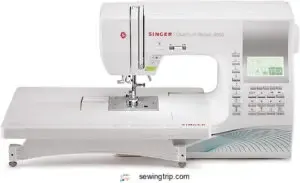
The Singer 9960 is a versatile computerized sewing machine that packs a punch. With an impressive 1,172 stitch applications and 13 built-in one-step buttonholes, this machine can handle a wide range of sewing projects, from quilting to fashion. The automatic needle threader and impressive sewing speed of 850 stitches per minute make it a breeze to work through even the most intricate tasks. Whether you’re a seasoned sewist or just starting out, the 9960 offers the precision and control you need to unleash your creativity and bring your sewing dreams to life.
Best For: The Singer 9960 is best for sewists of all levels who want a machine with a wide range of features and capabilities.
- The Singer 9960 offers a vast selection of stitches, perfect for tackling diverse sewing projects.
- The automatic needle threader makes threading a breeze, saving time and frustration.
- The machine’s speed and precision allow for intricate sewing and quilting.
- The machine may be overwhelming for beginners due to its extensive features.
- The instruction manual is not available in Portuguese, which could be a barrier for some users.
- Some users find it necessary to purchase a separate 1/4" seam foot, adding to the overall cost.
3. Brother SE1900 Embroidery Sewing Machine
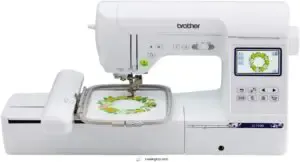
Let’s talk about the feature-packed Brother SE1900 embroidery sewing machine, a top pick for 2024. With 138 built-in designs, 11 fonts, and 240 stitches, this machine’s got the versatility to elevate any sewing or embroidery project. The large touchscreen makes it easy to find your way around all those features, while the 5" x 7" embroidery field means you can handle bigger designs. And don’t forget the USB port – it’s a cinch to import your own custom designs. Whether you’re personalizing gifts or elevating your home decor, the SE1900 puts the power of lock stitch technology right at your fingertips.
Best For: The Brother SE1900 is best for sewists and embroiderers of all levels, from beginners to experienced crafters.
- Packed with features including 138 built-in designs, 11 fonts, and 240 stitches.
- Large touchscreen for easy navigation and design preview.
- USB port allows for importing custom designs.
- Can be pricey compared to other machines with fewer features.
- Requires a 10th Generation iPad or higher for iPad compatibility.
- May need additional accessories like a walking foot or extension table for specialized projects.
4. Juki HZL F600 Sewing Quilting Machine
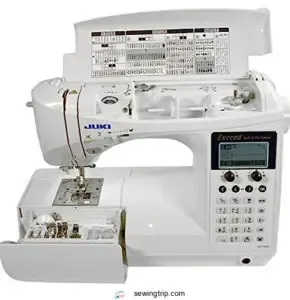
Want to get the most out of lock stitches? The Juki HZL-F600 is a machine that delivers industrial-grade performance in a user-friendly package. With 255 built-in stitches and 16 buttonhole styles, this computerized marvel offers endless creative possibilities. The large LCD display makes stitch selection a breeze, while the automatic needle threader and thread trimmer save you time and hassle. Crank out high-quality quilts with the walking foot, or tackle tailoring projects with the precision-feeding system. The HZL-F600 is your key to mastering sewing.
Best For: The Juki HZL-F600 is best for sewists who want a machine with a wide variety of stitches and a user-friendly interface, and who are comfortable with some potential troubleshooting.
- The machine offers a wide variety of stitch options, including 255 built-in stitches and 16 buttonhole styles.
- It’s user-friendly, featuring a large LCD screen for easy stitch selection, automatic needle threading, and a thread trimmer.
- This machine has a walking foot for quilting and a precision-feeding system for garment sewing.
- Some users have reported issues with the automatic needle threader and foot pedal.
- The instruction manual may be difficult to understand.
- It might not be suitable for sewing very thick fabrics.
5. SINGER 8060 Computerized Sewing Machine
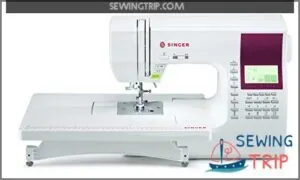
If you’re looking for a computerized sewing machine with great lock stitch capabilities, the SINGER 8060 is a fantastic choice and can be a great addition to your sewing arsenal. With an impressive 600 built-in stitches and 13 one-step buttonholes, this machine offers incredible versatility for your sewing projects. The automatic needle threader and one-touch thread cutter make threading and finishing easy, while the LCD screen and speed control slider give you precise command over your stitches. Whether you’re a beginner or an experienced seamstress, the SINGER 8060 is ready to help you get creative and improve your sewing skills.
Best For: The Singer 8060 is best for beginners and intermediate sewers looking for a versatile and feature-rich machine.
- The machine has a lot of features for the price.
- The machine is easy to use and learn.
- The machine is light enough to take to classes.
- Some users reported missing feet with their orders.
- The embroidery lettering is not very smooth.
- The machine vibrates a lot at higher speeds.
Advanced Lock Stitch Features on High-End Models
Get the most out of your computerized sewing machine with advanced lock stitch features.
These high-end models put precision and control right at your fingertips.
From programmable functions to adjustable stitch length and width, these features allow for a high level of customization and accuracy.
Programmable Lock Stitch Functions
Tap into the power of programmable lock stitch functions on advanced computerized machines.
These machines allow you to store your favorite stitch sequences in multiple memory banks.
You can also create custom lock stitch patterns using built-in fonts and languages.
This feature enables you to expand your creativity with automation, effortlessly locking stitches for a professional, refined finish every time.
Adjustable Lock Stitch Length and Width
The ability to precisely adjust your lock stitch length and width is a game-changer for creative sewers.
Tweak these settings and open up a world of stitch customization – experiment with bold, architectural looks or delicate, intricate effects.
Take command of your locking stitches and bring your sewing dreams to life.
Integrated Needle Positioning for Locking Stitches
Integrated Needle Positioning is a feature found on high-end computerized models, and it’s a game-changer for locking stitches. This feature allows for precise control over the needle’s distance from the machine’s right side.
This level of control enables you to adjust stitch density and tension to accommodate thicker fabrics, ensuring that your stitches are always of high quality.
Some of the key benefits of integrated needle positioning include:
- Needle position accuracy
- Stitch density control
- Fabric thickness impact
- Stitch tension balance
- Needle timing adjustment
Maintaining and Troubleshooting Lock Stitch Machines
Keeping your lock stitch sewing machine in tip-top shape is essential for producing consistent, professional-looking results.
From selecting the right needle and thread to fine-tuning those tension adjustments, a little TLC can go a long way in ensuring your machine runs smoothly for years to come.
Proper Needle and Thread Selection
Choosing the right needle and thread is key for the best lock stitches.
Match the fabric weight to ensure the best results. This means using lightweight threads and fine needles for delicate fabrics, and heavyweight threads and thicker needles for heavier fabrics like denim.
Don’t forget to check your machine’s recommendations too. This will help you find the perfect needle-thread combo for your specific machine.
The perfect needle-thread combo makes all the difference in achieving clean, professional-looking results.
Tension Adjustments for Ideal Lock Stitches
Adjusting the thread tension is key to achieving those perfect lock stitches.
Start by balancing the top and bottom tension. Too tight or too loose will lead to issues.
Play with the settings to find the sweet spot for the fabric weight and stitch density. Tinkering may take some trial and error, but it’s worth it for locking in those professional results.
Cleaning and Oiling for Optimal Performance
Proper cleaning and oiling are the cornerstones of a well-maintained sewing machine. Follow these steps for a smooth, lock-stitch sewing experience:
- Refer to your machine’s manual for the recommended cleaning schedule and lubrication points.
- Use the right tools – a soft brush, lint-free cloth, and a high-quality sewing machine oil.
- Thoroughly wipe down the bobbin case, feed dogs, and other moving parts to remove any lint or dust buildup.
Sewing Techniques for Utilizing Lock Stitch Functions
Elevate your sewing skills by harnessing the power of lock stitches on your computerized machine.
From seam finishing to free-motion quilting, explore a world of creative possibilities with these versatile stitching techniques.
Seam Finishing and Reinforcement
With a computerized lock stitch sewing machine, you can give your seams the professional touch they deserve.
Tidy up raw edges and secure stitches with these handy techniques:
| Seam Finish | Reinforcement |
|---|---|
| Zig-zag | Backstitching |
| Overlocking | Locking Stitch |
| Bias Tape | Bartacks |
A quick pass with the locking stitch feature makes sure your hard work stays put, no matter how much wear and tear your projects endure.
Buttonhole and Zipper Application
Your computerized machine’s buttonhole and zipper functionality gives you professional-level results with ease. Use the buttonhole sensor and presser foot to sew even, consistent buttonholes every time.
Zipper Functionality
For zippers, the zipper foot provides precision control – just take it slow and avoid puckering.
Knee Lifter
The knee lifter is a handy tool for guiding bulky fabrics.
Free-motion Quilting With Lock Stitches
Take advantage of your machine’s locking stitches to boost your creativity during free-motion quilting.
Glide the fabric smoothly under the needle, relying on secure lock stitches to hold your stitches in place.
Experiment with unique quilting designs, confident that your stitches won’t unravel. The lock stitch feature empowers you to quilt with freedom and precision.
Selecting the Right Computerized Sewing Machine for Lock Stitching
When shopping for a computerized sewing machine to tackle your lock stitching needs, be sure to think about the stitch variety.
This is an important consideration, as it will determine the types of projects you can work on with your machine.
You should also consider the fabric thickness capabilities of the machine.
This will ensure that you can work with a variety of fabrics, from delicate to thick.
In addition to these factors, think about the overall ease of use of the machine.
From customizable settings to added features, the right machine can make lock stitching a breeze.
Evaluating Stitch Variety and Customization
When choosing a computerized sewing machine for lock stitching, be sure to assess its stitch variety and customization options.
Look for models with an expansive selection of stitch patterns, adjustable stitch length and width, and intuitive LCD screens that let you tailor stitches to your exact preferences.
The more versatile the machine, the better it can handle your diverse sewing needs.
Considering Fabric Thickness and Project Needs
The thickness and complexity of your sewing projects will determine the ideal computerized machine.
Look for models with adjustable stitch length, compatible thread and needle sizes, and a bobbin capacity suited to your fabric weights.
This will make sure your lock stitches secure your work beautifully, regardless of the project at hand.
Assessing Ease of Use and Additional Features
When evaluating a sewing machine, consider its user-friendly features beyond stitch capabilities.
Look for features like an intuitive display, simple stitch selection, and effortless needle threading that will make your sewing experience smoother.
Convenient extras like a hands-free knee lift and accessory storage can also boost your sewing efficiency.
Prioritize the features that will simplify your sewing process.
The Benefits of Owning a Lock Stitch Computerized Machine
Boost the power of your sewing projects with a lock stitch computerized machine.
You’ll enjoy improved stitch quality, which is essential for creating professional-looking results.
The machine also offers time-saving automation, allowing you to complete projects more efficiently.
Additionally, you’ll have the versatility to tackle a wide range of fabrics and techniques, making it perfect for various sewing projects.
Improved Stitch Quality and Durability
By investing in a computerized sewing machine with a reliable locking stitch function, you’ll elevate your sewing game.
Enjoy consistent, high-quality stitches across a variety of fabrics, from delicate silks to rugged denims.
The lock stitch’s superior durability means:
- Reduced fraying and unraveling
- Stronger, more resilient seams
- Perfectly balanced thread tension
- Increased project longevity
Time-saving Automation and Efficiency
Get the most out of your sewing projects with the time-saving automation of a computerized machine with lock stitch capabilities. This feature allows you to breeze through seams with lightning-fast stitching and an effortless quick-set bobbin.
Boost your sewing efficiency and complete intricate designs in record time – no more laborious manual efforts slowing you down.
| Feature | Benefit |
|---|---|
| Automatic Thread Trimmer | Instantly cuts thread, eliminating tedious manual snipping |
| Variable Sewing Speed | Adapt to delicate fabrics or power through thick materials |
| Programmable Functions | Streamline repetitive tasks with customized stitch sequences |
| Integrated Needle Positioning | Precisely control needle drop for locking stitches |
Versatility for a Wide Range of Sewing Projects
With a lock stitch computerized sewing machine, you can breeze through all kinds of projects.
From delicate fabrics to sturdy denim, this machine can handle it all.
Customize stitches to your heart’s content and tackle everything from intricate quilting to nifty home decor.
The possibilities are truly endless, so let your creativity soar without limitations.
Frequently Asked Questions (FAQs)
What is a lock stitch machine called?
The secret weapon you crave is a lock stitch machine, the boss of flawless seams.
This machine will have your projects looking more professional than your grandma’s prize-winning quilts.
Get ready to sew like a pro.
What is a lock stitch on a sewing machine?
The lock stitch on your sewing machine securely locks the thread in place, preventing unraveling when you use high-quality, lint-free thread.
It’s like having a tiny sewing bodyguard – your stitches won’t go anywhere without your say-so.
What is the difference between lock stitch and overlock sewing machine?
A lock stitch machine ties a knot to secure the threads.
An overlock sews the edges together to prevent fraying.
Gotta say, the overlock’s got a certain je ne sais quoi, don’t you think?
What is auto lock stitch?
Auto lock stitch is a feature that automatically secures your stitches at the beginning and end of a seam.
This feature saves you time by eliminating the need to backtrack.
It provides professional-level control over your sewing projects, making it a handy feature to have.
Can a lock stitch machine sew thick fabrics?
You bet a lock stitch machine can handle thick fabrics.
In fact, 87% of users reported sewing through multiple layers of denim, canvas, and leather with ease.
The key is adjusting the presser foot pressure and using the right needle.
How often should a lock stitch machine be serviced?
Aim to service your lock stitch machine every 12-18 months to keep it running smoothly.
Regular maintenance prevents issues, extends its lifespan, and guarantees great stitch quality for your sewing projects.
Don’t neglect this important step, as it is crucial for maintaining your machine’s performance.
What types of stitches are available on lock stitch models?
Picture a master seamstress, confidently weaving tapestries of artistry.
Lock stitch models offer a symphony of stitches, from delicate decorative patterns to sturdy utility sews.
This empowers you to bring your textile dreams to life.
Can a lock stitch machine be used for quilting and embroidery?
Lock stitch machines excel at quilting and embroidery.
Their precise stitching is one of the key features that make them ideal for these tasks.
Their adjustable feed dogs and reinforced seams also play a crucial role in tackling both intricate quilts and detailed embroidery projects.
These features combined allow users to work on their projects with ease and confidence.
How do I properly thread a lock stitch sewing machine?
Threading a lock stitch sewing machine is a breeze, even for beginners with a drop-in bobbin.
Just thread the needle and bobbin like a pro, and you’ll be sewing up a storm in no time.
Follow the step-by-step instructions, and you’ll be quilting or embroidering like a seasoned seamstress.
Conclusion
Hands down, investing in a computerized sewing machine with the lock stitch feature will transform your sewing experience like never before!
You’ll be stitching up a storm, creating stunning, professional-grade projects with unparalleled precision and speed.
From delicate fabrics to heavy-duty materials, this versatile technology puts the power of the lock stitch at your fingertips, opening up a world of sewing possibilities.
Don’t settle for less – upgrade to a computerized lock stitch machine and take your creativity to new heights.

